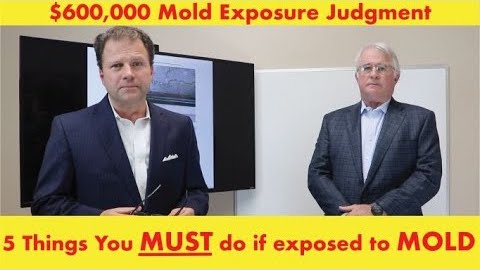On the heels of a $600,000 mold lawsuit victory, lawyers Chris Estes, Esq., and Pete Mackey, Esq. have tips for tenants who might be faced with mold growth in the home or apartment they are renting.
Estes, of Estes Law Firm, LLC, previously defended large corporations and insurance companies. Now he sues them.
His practice revolves exclusively around representing individuals and families who have been injured or damaged, he says.
Mackey, of Burns, Cunningham & Mackey, P.C. is a lawyer of 40 years with 30 years’ trial litigation experience.
The case they tried took place in Mobile County, Alabama.
It involved a family who was renting a home that had “continuous water intrusion.”
Water intrusion led to mold, and then to personal illness suffered by the occupants.
Property management repeatedly told the tenants (their clients) that they would fix the problem, yet didn’t.
The winning trial lawyers laid out these tips for other tenants who may be experiencing mold in a property they are renting.
This article is provided for educational / informational purposes only and is not personal legal advice of any kind.
“The owners of these condominiums did what we’ve seen over and over. They told our folks that they would fix the problem and then didn’t. That caused us to push it to trial, which resulted in a $600,000 judgment.”
Peter Mackey, Esq.
1. Put your landlord and the building’s owner on notice in writing
Estes and Mackey say tenants need to put their landlord and the building’s owner on notice in writing if they suspect water intrusion, water damage, or mold growth.
Do this immediately; the earlier the better.
The notice MUST be in writing, and it should be sent exactly as outlined in your lease.
Your lease may not detail exactly how to report water damage or mold specifically, but it does say in what format notices are to be made to the landlord and owner. (It may be by email, and/or by letter via the post office to a specific address).
“The reason we’re telling you this is because that’s what the law says,” the lawyers shared.
They say you also need to give property management or the landlord the “chance to fix it.”
How to Send the Letter
“I know this sounds like a lawyer answer, but the notice needs to be sent according to the terms in your lease/rental agreement. Towards the end of your lease, there should be a provision (or some language) entitled “notice” or something like that — you are looking for the provision and language that sets out how notices are to be provided to the landlord/owner if there is a problem. Then, the notice letter needs to be sent to the exact address that is designated in that provision and sent exactly how that provision says notice is to be provided. If it says certified, then do certified. If it says email, do email. Look closely because sometimes the notice address will be different from where you send your rent. You should send to that notice address and you should also send a copy to wherever you send your rent. Certified would not hurt for the extra copy. Like we said in the video, include the details of the problem and request that it be fixed. There really isn’t a specific format. Just keep the substance of the notice letter to the point, give the details of the problem you have and politely request that it be fixed. Hope this helps and thank you for watching the video and thank you for the comment.” – Estes Law Firm, in answer to viewer question: “Does the letter putting the owner/landlord on notice need to be sent by certified mail or any other specific format?”
2. Document the situation with ‘lots of pictures’
In the notice you provide to your landlord and property management, provide photographs of whatever it is that indicates water intrusion/damage, as well as mold growth.
“You can’t get too many [pictures]…. make sure that you’re as specific as you can be.”
The winning legal team says to show where and when the pictures are being taken.
One way to do this (not suggested by the legal duo) is to include the day’s newspaper in the photographs, which you can use your cell phone to take.
Continue to take photographs as and if the water intrusion/damage and mold growth continue to develop.
Use your phone to take photographs and to record written notes
“You have everything you need right here with your cell phone to do this,” they say.
“Take the pictures with your phone, take a lot of them, and take them often.
“And the other thing you can do is go to your phone in the notes section and just create notes with dates and times of who you talk to, when you talk to them, what you talked about.
“The who, the what, the when, the where, and the photographs to back that up are very important.”
“We have learned that photographs are an absolute necessity to document the extent of the damage in the home, the progression of the mold, the spread of the mold, and the problems that our clients have had to live with,” they said.
What to photograph:
- Water intrusion in any/all areas of the home
- Leaks in any/all areas of the home
- Water damage anywhere
- Mold growth everywhere it appears
- Physical reactions you might be having to the mold
3. Have professional environmental testing done for mold
The legal team advises tenants to have professional testing done for mold.
Do not use the mold tests that are available at Home Depot, at WalMart, or on Amazon for this.
These tests are “just about useless,” the lawyers say. “They don’t really show you anything, and they’re inaccurate.”
The team advises tenants to hire an industrial hygienist who will come out and take air samples and swab samples and then generate a report that details the specific types of mold that are present and in what amounts.
“We always use industrial hygienists in the cases that we file in court,” they say. Their test results are “the only thing that are going to be accepted by the courts. You won’t be able to get a do-it-yourself test into evidence.”
The team shows the report used in the case just won, which report they say “found an alarming amount of two types of mold” in the tenant’s bedroom and den.
4. Seek medical treatment for any health problems you may be having
Mold exposure, especially over a long period of time, leads to adverse health reactions in many people.
Tenants with known water intrusion/damage and mold problems in the home should seek medical attention, and keep a detailed record of all doctor’s visits, tests conducted, blood work, etc.
Dates, times, doctor’s names, invoices, receipts, and all paperwork should be preserved.
Symptoms for which you might seek medical attention, the legal team says, can include:
- Itching eyes
- Sore throats
- Sinus problems
- Respiratory problems
- Joint pain
- Memory loss
The team suggests that any tenant with mold problems should meet with their doctor and “tell them what’s going on in your life,” and “show [the doctor] pictures of the mold that’s in your home.”
They suggest providing your doctor with pictures of the bubbling paint, and painting a picture of what it smells like in the home, how long you have been living there, and any results of the professional mold testing that was done in the space.
The exact method of medical testing the legal team advises is called “mass spectrometry,” (MS) which they say not a lot of doctors really know about.
5. Get mold remediation by a certified mold remediator
The final point the legal duo suggests is that tenants whose leased apartments or homes are affected by water damage and mold growth should be sure that proper mold remediation is done by a certified mold remediator.
“Some bleach and a coat of paint do good to gloss over the problem but that it doesn’t fix it,” they say.
If the source of the moisture isn’t located and fully resolved, the problem will return.
In some cases, parts of the home have to be removed if they are moldy—carpets, cabinets, drywall or sheetrock, etc.
Mold remediation should always be done by a properly trained, licensed, and certified mold remediator. And that is especially true if you believe the mold in the home or apartment you are leasing is so severe as to possibly warrant a lawsuit.
Watch the full video here: What to Do if Exposed to Mold | 5 Steps to Protect Family and Make a Claim | $600,000 Mold Case. — Note: This video has since been set to “Private” by the law firm that produced and posted it.




